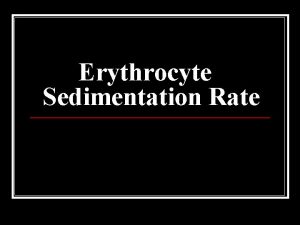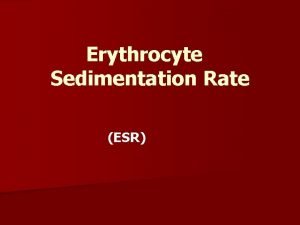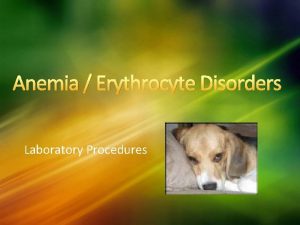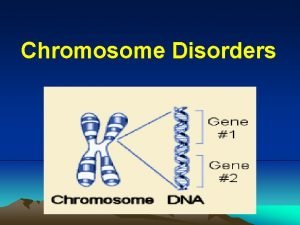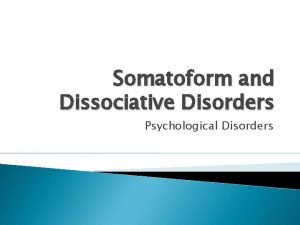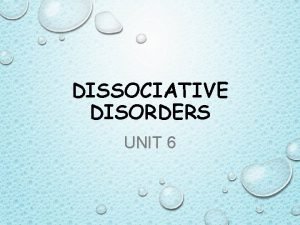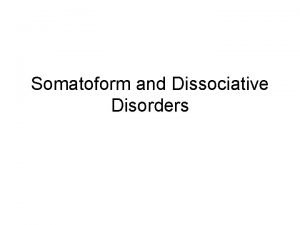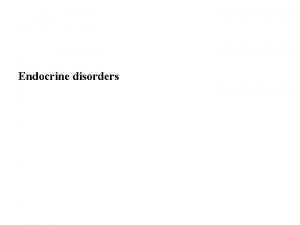Erythrocyte Disorders Read through these in your notes
















- Slides: 16


Erythrocyte Disorders • Read through these in your notes and in your text to make sure you understand the causes and/or symptoms • They will be on your Quiz

Hemolytic anemia

Aplastic Anemia

Thalassemia

Sickle Cell Anemia

Leukocyte Disorders • Read through these in your notes and in your text to make sure you understand the causes and/or symptoms • They will be on your Quiz

Disorders of Hemostasis • Type I: Thromboembolytic conditions – undesirable clot formation – Thrombus: clot that develops in an unbroken blood vessel – Embolus: thrombus that breaks away from BV wall and floats freely in bloodstream • Either may block circulation to tissues beyond the occlusion and cause death to those tissues • Pulmonary embolism, stroke, heart attack

Disorders of Hemostasis • Endothelial roughening: impairment of endothelial characteristics such as arteriosclerosis, severe burns/scar tissue, or inflammation may give platelets a place to cling and begin a thrombus • Blood stasis: slowing of blood flow particularly in immobilized patients does not keep clotting factors diluted

Disorders of Hemostasis • Bleeding disorders: prevention of proper clot formation – Thrombocytopenia: platelet count under 50, 000 per mm 3 • Petechiae: small purplish blotches (bruises) caused by spontaneous bleeding from small BV all over body • Cause: damage to myeloid tissue (bone marrow): bone marrow cancer, radiation, certain drugs • Treatment: whole blood transfusion or in some cases platelet transfusion

Disorders of Hemostasis • Impaired liver function – Little to no procoagulants produced – Causes: vitamin K deficiency, hepatitis, cirrhosis • Vitamin K is a fat soluble vitamin produced in your intestines by bacteria: liver produces bile which is necessary for fat absorption – No bile = no fat absorption = vitamin K deficiency = no procoagulant production – Treatment: Depends on cause

Hemophilia: What is it? • Hereditary X linked trait so usually affects males – Hemophilia A = factor VIII deficiency – most common – Hemophilia B – factor IX deficiency – Hemophilia C – factor XI deficiency • Symptoms: minor tissue trauma causes prolonged bleeding, bleeding into joint capsules after exercise or trauma • Management: clotting factor transfusion

Developmental Aspects • Embryonic – Day 28 of pregnancy – RBC in fetal circulation – By 7 th month: red marrow is chief site of hematopoiesis – Hb. F – fetal hemoglobin • Greater ability to pick up oxygen • Replaced by Hb. A after birth • Immature liver may lead to physiological jaundice since bilirubin is not excreted

Developmental Aspects • Adulthood – Dietary deficiencies or metabolic disorders cause abnormalities in BC formation or hemoglobin production – Iron deficient anemia more common in women

Developmental Aspects • Old age – Leukemia risk – Pernicious anemia • Stomach mucosa atrophies with age • Less intrinsic factor (located in lining of stomach – function is B 12 absorption) • Less B 12 absorption • Leads to pernicious anemia

Diagnostic Blood Tests • • • low hematocrit = anemia high fat level (lipidemia) = problems with heart disease blood glucose test – diabetes, hypoglycemia, hyperglycemia differential WBC indicates type of infection platelet count – thrombocytopenia – clotting problems complete blood count = CBC – – includes all aspects of blood – typically done to eliminate possibilities or give doctors a direction to go
 Corrected esr
Corrected esr Rodak
Rodak Read these sentences
Read these sentences Read the advertisement below
Read the advertisement below Give us your hungry your tired your poor
Give us your hungry your tired your poor How to read literature like a professor chapter titles
How to read literature like a professor chapter titles What are these notes
What are these notes Cache coherence nedir
Cache coherence nedir Read through the syllabus
Read through the syllabus Facteur g
Facteur g Through one man sin entered
Through one man sin entered Class 2 furcation
Class 2 furcation What is conversion of timber
What is conversion of timber Entertainment poem
Entertainment poem Read the extract from your pen-friend letter
Read the extract from your pen-friend letter 2 read and answer. write in your notebook
2 read and answer. write in your notebook Read the advertisement below and answer the questions
Read the advertisement below and answer the questions

















